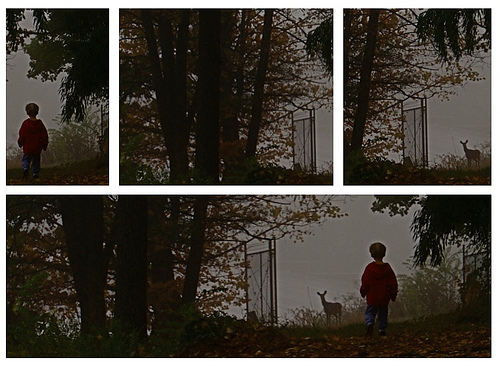The goal was to take one photo and chop it up to make something that tells a story or creates some kind of tension by breaking the image into pieces. I had the idea for the “assignment” after seeing this shot1 on #FFFFFound.
I’ll rate this one a partial success. It’s not quite what I want. I don’t feel the upper shots are as interesting individually as they should be. I wanted to make it seem like the boy was walking into the woods seeing nothing, then as he traveled deeper he spotted the deer and that moment- when he froze finally seeing the deer is the moment captured in the final pane.
1 Which isn’t a single image but is close enough for me.


Actually I think the upper three could work without the bottom one. I think I’m going to add this to my pre-ap design class.
This assignment is super tough. You need a photo that has small details separated enough to pull out.
I might disagree with Brandi. The three alone do not say anything. The trick is to look at the top three w/o seeing the bottom one first.
If you can block out the bottom, you introduce a character, then a place, then a second character- without the bottom, there is no connecting the boy to the deer.
Or maybe without the bottom one… there i a sad boy, he goes for a walk in the deep, scary woods his parents told him to stay away from. The boy walks through a magical sheet and turns into a deer.
Okay, maybe that is more fun.
No end of fun.
I think Brandi has a point. I just really like the end shot so it’s hard to drop it. That may be more from an emotional connection than any sort of narrative need.
Maybe I should have set it up so that it was wider than the viewable screen and had the final shot “off stage” so that you had to scroll to see it.
This is yet another great assignment, did you submit this to ds106 with your brilliant example?
Submitted. Alan already did one with a horse a week or two ago. I used a pigeon picture from #FFFFound for the example.
What is ds106? Does your district archive lessons?
It’s an open online course organized around digital storytelling. It’s being run through UMW and it’s in the MOOC format.
We archive some lessons- around 21st century skills and some other work depending on the subject.
that first link doesn’t work!
Sorry about that. It’s http://ds106.us/. I think I did .org by mistake the first time.